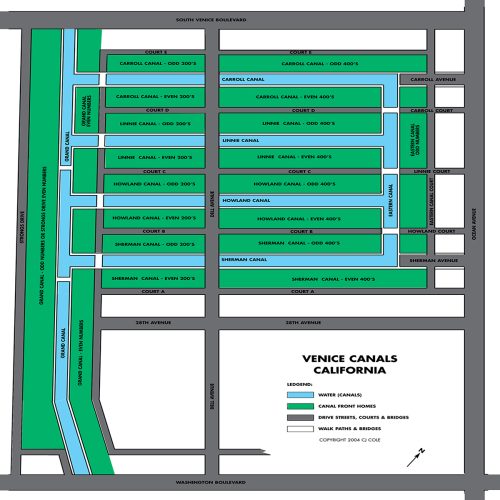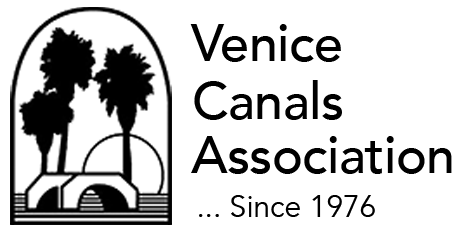About the canals
The Venice Canals community is located in the Venice neighborhood of the City of Los Angeles, a few blocks from Venice Beach. The Venice Canals are located south of the City of Santa Monica, north of Marina del Rey, and just east of the iconic Venice Beach Boardwalk and the Pacific Ocean. The Venice Canal Historic District is listed on the City of Los Angeles Historic Places Register, and the National Register of Historic Places, Reference Number 82002193.
The Canals are comprised of six canals, approximately one and a half miles in length, fifty feet in width, and five feet deep at center. The Canals are laid out in a grid. Carroll, Linnie, Howland, and Sherman Canals run in an east to west direction; Eastern and Grand Canal run north to south. The one-way vehicular entrance to the Canals is at Dell Avenue and Sherman Canal. Dell Avenue traverses four bridges in a south to north direction. Access to the homes from Dell Avenue is provide by Courts A, B, C, D, and E (See map below.) In addition, nine footbridges provide pedestrian access within the Canals.

HISTORY
Abbott Kinney and his Vision: Venice in America
On July 4th, 1905, Abbott Kinney opened Venice in America to a crowd of 40,000 amazed Los Angelenos and tourists.
Abbott Kinney had great imagination and curiosity. He was born in New Brunswick, New Jersey in 1850, and grew up in Washington, DC. He left for Europe when he was 16 years old. He spent a year at the University of Heidelberg, and two more years at the Sorbonne in Paris and traveling through Switzerland and Italy. Abott Kinney’s time spent in the elegant capital cities of Europe would influence his dreams for the scrappy town of Los Angeles.
Abbott Kinney first arrived in California in 1880, when he traveled to San Francisco. Someone suggested he should visit Los Angeles, because the climate might be good for his asthma. With money from his family’s tobacco business, Mr. Kinney began to invest in property along the beach and elsewhere in Los Angeles. His first important project was Ocean Park. Abbott Kinney and his partner Francis Ryan built the playground that became the Santa Monica Pier and boardwalk. Mr. Ryan died suddenly in 1898. Mr. Kinney didn’t want to work with the group of men who purchased Mr. Ryan’s share of the business, so he sold his interest and turned his attention south, towards the undeveloped wetlands and marshes.
In 1904, Abott Kinney began to build Venice in America, a few square miles of canals, bridges, and private homes that would be a showcase for American ingenuity—and a reference to Venezia, the great Italian Renaissance city. Venice in America was a great success. Families travelled by electric trolley cars from downtown Los Angeles and nearby Santa Monica to visit Mr. Kinney’s second triumph. In formal suits and long flowing dresses, men, women, and children took gondola rides down the canals, and posed for the new century’s photographers.
Borrowing on Mr. Kinney’s success, a second group of investors built another set of canals to the south, the New Amsterdam Canals. Two of the surviving canals, Sherman and Howland, carry the names of the New Amsterdam builders. Most of the homes built by the developers were small, one-story cottages, intended for summer use.
In the 1920s and 1930s, Los Angeles became a car culture. Gradually, Mr. Kinney’s canals were drained and paved over. The gondolas were replaced by sedans and coupes, Lion Canal became Windward Avenue—the heart of modern Venice— and Venice Boulevard expanded to a west-east artery that runs from the beach to Downtown Los Angeles.
By 1940, the sidewalks on either side of the remaining canals had deteriorated and were taken out of public use. Between 1991 and1993, the City of Los Angeles undertook a major renovation project to restore the remaining Venice Canals. Workers excavated the canals to a depth of five feet at center, built retaining walls on the sides of the canals, constructed new sidewalks, and planted a saltbush shrubs along the walkways.
If you want to explore the legacy of Abbott Kinney, you can spend an afternoon strolling down Abbott Kinney Boulevard, a few blocks of Uber cool shops and restaurants that run from Brook Avenue to Venice Boulevard, and further south. Or you can visit Mr. Kinney himself. Abbott Kinney, the founder of Venice in America, stands above modern Venice as a four-story mural at the corner of Venice Boulevard and Pacific Avenue, near the north entrance to today’s Venice Canals.
